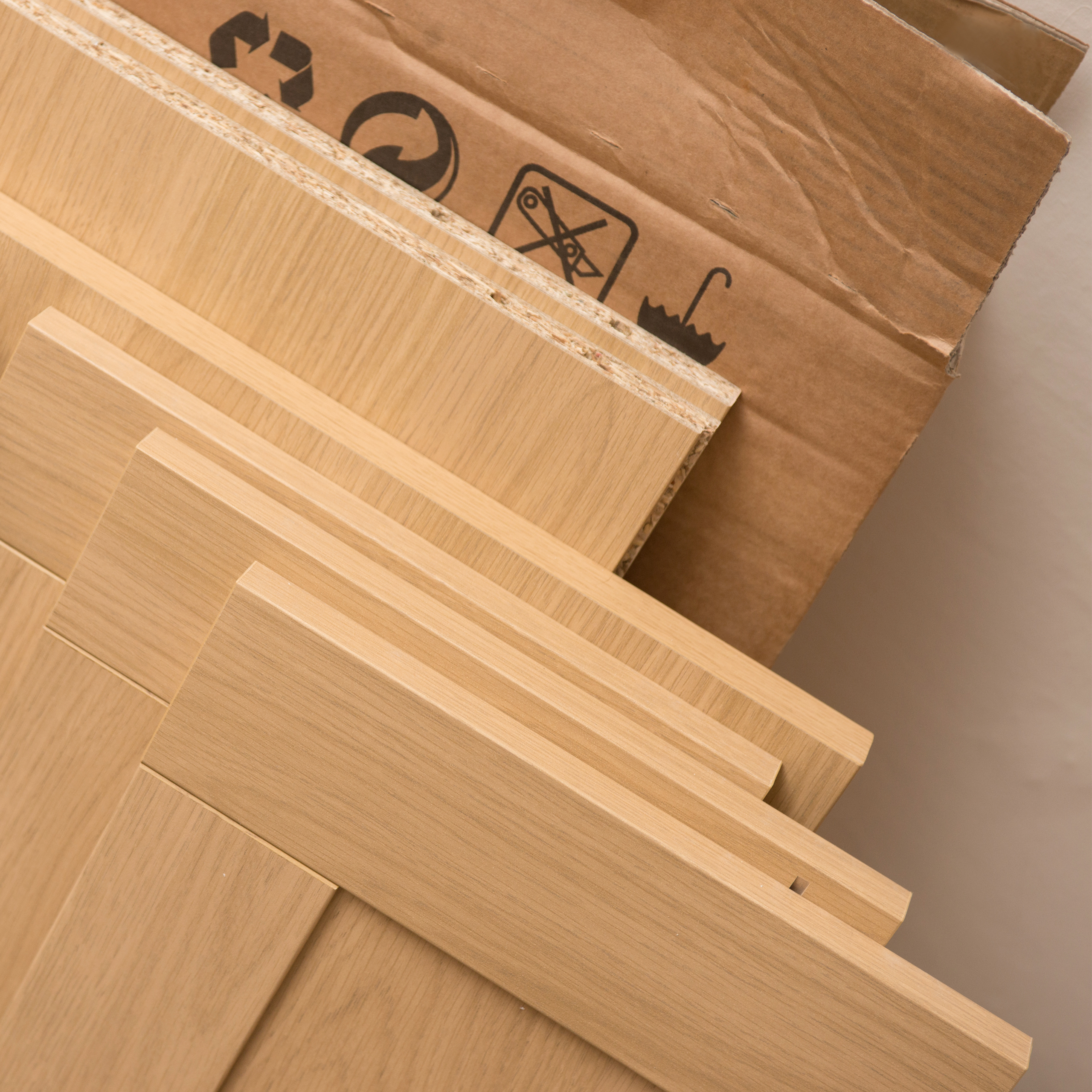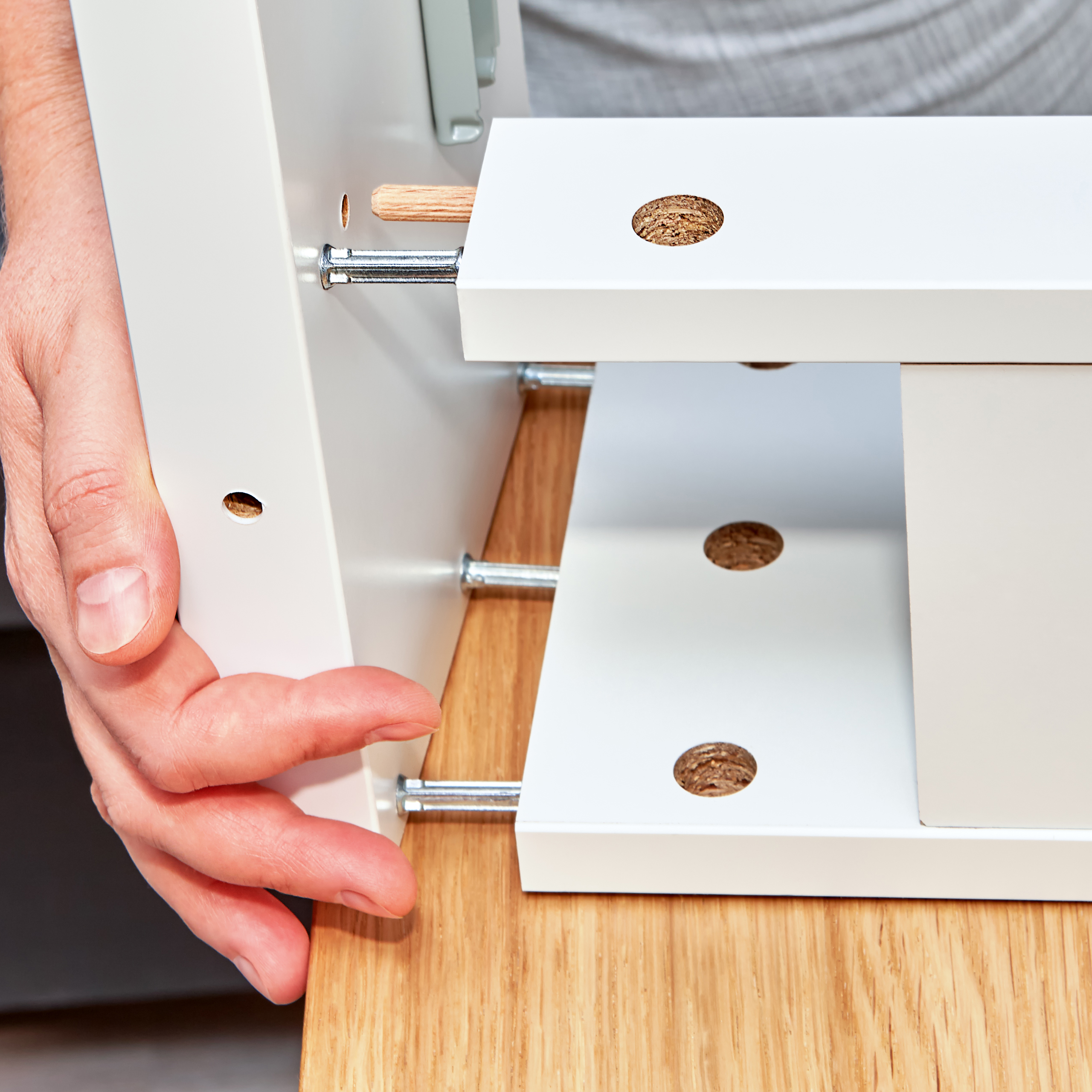09 Feb Flat pack, pre-assembled, rigid – what’s the difference?
flat pack, pre-assembled, rigid
what’s the difference?
Flat pack
Well let’s start with the entry level product which is the good old “flat pack” As the name suggests the kitchen is delivered flat to be assembled by the buyer. Because the manufacturer needs to produce a product that can be assembled by someone with limited experience and little more than a screwdriver and Allan Key, the tolerances used needs to allow for different standards of assembly. Which is why, when you try to push an assembled flat pack cabinet from side to side the cabinet itself will rock out of shape as all that is holding each corner together is a Cam holding a single screw in each corner.
Flat packs are usually, but not always, manufactured with the cost being the critical factor and compromises will be made in order to allow for the ease of assembly. One example of this is the actual size of the door fitted to the cabinet. Some flat pack manufacturers will for example produce their doors 10mm narrower than the cabinet itself. The compromise being the gaps between each door. Aesthetically the tighter the gap between doors the better the look. A rigid cabinet usually has a door of, at the most, 6mm less than the width of the cabinet, doesn’t sound like much but that is actually a 40% decrease in the width of the door gap compared to some flat packs.
Pre-Assembled
Pre-assembled kitchens come with the same issues as flat pack kitchens mentioned above, but are assembled by either the factory or the installer on-site. The downside is that the customer will be charged extra for the pre-assembly, either at the point of purchase or in the form of an additional cost charged by the installer. It is not unusual for even a professional installer to take a good 2 days to assemble all of the units in the average kitchen. Hence some very hefty installation charges by some of the larger flat pack kitchen retailers. £5,000 plus is a very common installation price charged by some of the largest flat pack retailers and that’s without plumbing or electrical charges. A professional independent kitchen retailer’s installation charges would expect to be no more than £3000 for the same kitchen.
Rigid
Generally regarded as the best and usually the most expensive option, although some of the biggest German manufacturers have reached such a high volume, utilising state-of-the-art automated and robotic factories, that they can offer a price point very similar to even the average flat pack. Rigid kitchens are almost invariably glued and dowelled together and jointed on a jig or frame thus guaranteeing absolute millimetre accuracy and solid construction.
Another critical difference between the average flat pack and a made-to-order rigid kitchen is, most importantly the made to order bit. Flat pack manufacturers almost without exception produce their product in volume and store the flat pack units in a warehouse until the customer orders a kitchen the various cabinets are then “picked” to assemble the order. Some of the aforementioned cabinets may have been produce 5 minutes ago, others 5 months ago. Even more critical is that the flat pack manufacturer has no idea where any given cabinet is going to end up within in a kitchen, so allowances have to be made for the unit to be able to work in any scenario. For example, is a 600mm base cabinet going to be a sink unit an ordinary base unit, a hob unit or a drawer pack. The manufacturer doesn’t know, so drill holes are made within the cabinet to allow for every eventuality, hence the cabinet arrives with literally dozens of often redundant drill holes in it. Entry level flat packs may even have large holes drilled into the cabinet door to allow for left or right-hand hinges. Very ugly in our opinion.
A quick clue to identifying an entry level flat pack is if there is any unprotected or raw chipboard visible anywhere on the cabinet, whether it be at the front, back or to the rear of any rail, raw chipboard is bad news in any moist environment (and a kitchen can be a very moist environment) even if it is not visible after assembly, raw chipboard loves to absorb moisture and swell.
Flat pack
Well let’s start with the entry level product which is the good old “flat pack” As the name suggests the kitchen is delivered flat to be assembled by the buyer. Because the manufacturer needs to produce a product that can be assembled by someone with limited experience and little more than a screwdriver and Allan Key, the tolerances used needs to allow for different standards of assembly. Which is why, when you try to push an assembled flat pack cabinet from side to side the cabinet itself will rock out of shape as all that is holding each corner together is a Cam holding a single screw in each corner.
Flat packs are usually, but not always, manufactured with the cost being the critical factor and compromises will be made in order to allow for the ease of assembly. One example of this is the actual size of the door fitted to the cabinet. Some flat pack manufacturers will for example produce their doors 10mm narrower than the cabinet itself. The compromise being the gaps between each door. Aesthetically the tighter the gap between doors the better the look. A rigid cabinet usually has a door of, at the most, 6mm less than the width of the cabinet, doesn’t sound like much but that is actually a 40% decrease in the width of the door gap compared to some flat packs.
Pre-Assembled
Pre-assembled kitchens come with the same issues as flat pack kitchens mentioned above, but are assembled by either the factory or the installer on-site. The downside is that the customer will be charged extra for the pre-assembly, either at the point of purchase or in the form of an additional cost charged by the installer. It is not unusual for even a professional installer to take a good 2 days to assemble all of the units in the average kitchen. Hence some very hefty installation charges by some of the larger flat pack kitchen retailers. £5,000 plus is a very common installation price charged by some of the largest flat pack retailers and that’s without plumbing or electrical charges. A professional independent kitchen retailer’s installation charges would expect to be no more than £3000 for the same kitchen.
Rigid
Generally regarded as the best and usually the most expensive option, although some of the biggest German manufacturers have reached such a high volume, utilising state-of-the-art automated and robotic factories, that they can offer a price point very similar to even the average flat pack. Rigid kitchens are almost invariably glued and dowelled together and jointed on a jig or frame thus guaranteeing absolute millimetre accuracy and solid construction.
Another critical difference between the average flat pack and a made-to-order rigid kitchen is, most importantly the made to order bit. Flat pack manufacturers almost without exception produce their product in volume and store the flat pack units in a warehouse until the customer orders a kitchen the various cabinets are then “picked” to assemble the order. Some of the aforementioned cabinets may have been produce 5 minutes ago, others 5 months ago. Even more critical is that the flat pack manufacturer has no idea where any given cabinet is going to end up within in a kitchen, so allowances have to be made for the unit to be able to work in any scenario. For example, is a 600mm base cabinet going to be a sink unit an ordinary base unit, a hob unit or a drawer pack. The manufacturer doesn’t know, so drill holes are made within the cabinet to allow for every eventuality, hence the cabinet arrives with literally dozens of often redundant drill holes in it. Entry level flat packs may even have large holes drilled into the cabinet door to allow for left or right-hand hinges. Very ugly in our opinion.
A quick clue to identifying an entry level flat pack is if there is any unprotected or raw chipboard visible anywhere on the cabinet, whether it be at the front, back or to the rear of any rail, raw chipboard is bad news in any moist environment (and a kitchen can be a very moist environment) even if it is not visible after assembly, raw chipboard loves to absorb moisture and swell.
Conclusion
If you can find a rigid kitchen close in price to a flat pack then buy it, they’re better in every way. The only negative with a rigid kitchen is that it might take up to six weeks to get it – but it’s worth the wait.
 REQUEST BROCHURE
REQUEST BROCHURE SHOWROOM FINDER
SHOWROOM FINDER 03450 090 097
03450 090 097




